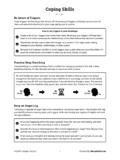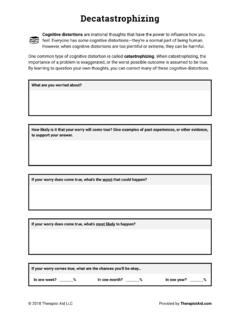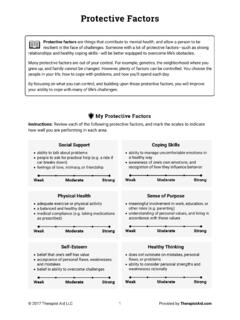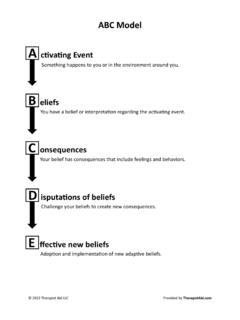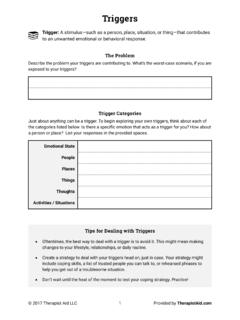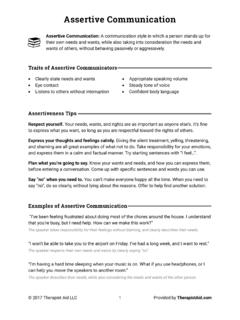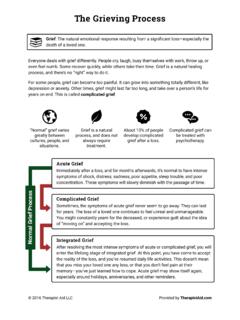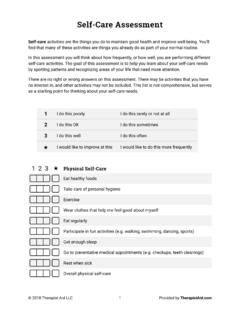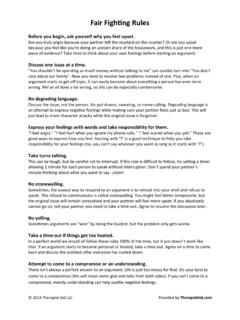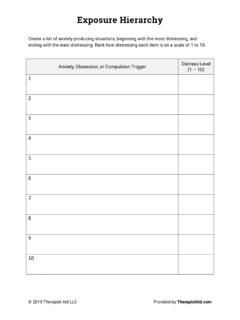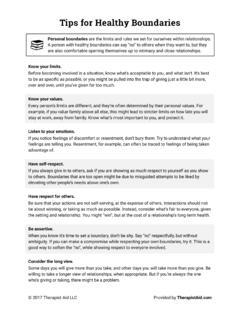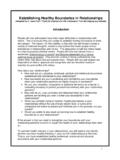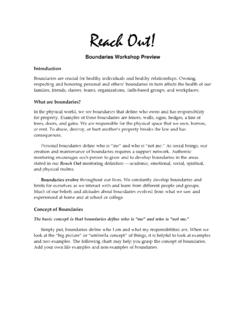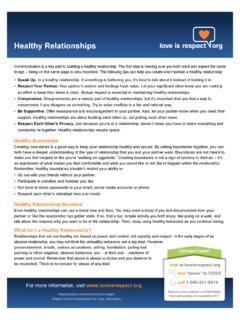Transcription of What are Personal Boundaries? - Therapist Aid
1 What are Personal boundaries ? 2016 Therapist Aid LLC 1 Provided by Personal boundaries are the limits and rules we set for ourselves within relationships. A person with healthy boundaries can say no to others when they want to, but they are also comfortable opening themselves up to intimacy and close relationships. A person who always keeps others at a distance (whether emotionally, physically, or otherwise) is said to have rigid boundaries . Alternatively, someone who tends to get too involved with others has porous boundaries . Common traits of rigid, porous, and healthy boundaries .
2 Rigid boundaries Porous boundaries Healthy boundaries Avoids intimacy and close relationships. Unlikely to ask for help. Has few close relationships. Very protective of Personal information. May seem detached, even with romantic partners. Keeps others at a distance to avoid the possibility of rejection. Overshares Personal information. Difficulty saying no to the requests of others. Overinvolved with others problems. Dependent on the opinions of others. Accepting of abuse or disrespect. Fears rejection if they do not comply with others. Values own opinions.
3 Doesn t compromise values for others. Shares Personal information in an appropriate way (does not over or under share). Knows Personal wants and needs, and can communicate them. Accepting when others say no to them. Most people have a mix of different boundary types. For example, someone could have healthy boundaries at work, porous boundaries in romantic relationships, and a mix of all three types with their family. The appropriateness of boundaries depends heavily on setting. What s appropriate to say when you re out with friends might not be appropriate when you re at work.
4 Some cultures have very different expectations when it comes to boundaries . For example, in some cultures it s considered wildly inappropriate to express emotions publicly. In other cultures, emotional expression is encouraged. What are Personal boundaries ? 2016 Therapist Aid LLC 2 Provided by Types of boundaries Physical boundaries refer to Personal space and physical touch. Healthy physical boundaries include an awareness of what s appropriate, and what s not, in various settings and types of relationships (hug, shake hands, or kiss?). Physical boundaries may be violated if someone touches you when you don t want them to, or when they invade your Personal space (for example, rummaging through your bedroom).
5 Intellectual boundaries refer to thoughts and ideas. Healthy intellectual boundaries include respect for others ideas, and an awareness of appropriate discussion (should we talk about the weather, or politics?). Intellectual boundaries are violated when someone dismisses or belittles another person s thoughts or ideas. Emotional boundaries refer to a person s feelings. Healthy emotional boundaries include limitations on when to share, and when not to share, Personal information. For example, gradually sharing Personal information during the development of a relationship, as opposed to revealing everything to everyone.
6 Emotional boundaries are violated when someone criticizes, belittles, or invalidates another person s feelings. Sexual boundaries refer to the emotional, intellectual, and physical aspects of sexuality. Healthy sexual boundaries involve mutual understanding and respect of limitations and desires between sexual partners. Sexual boundaries can be violated with unwanted sexual touch, pressure to engage in sexual acts, leering, or sexual comments. Material boundaries refer to money and possessions. Healthy material boundaries involve setting limits on what you will share, and with whom.
7 For example, it may be appropriate to lend a car to a family member, but probably not to someone you met this morning. Material boundaries are violated when someone steals or damages another person s possessions, or when they pressure them to give or lend them their possessions. Time boundaries refer to how a person uses their time. To have healthy time boundaries , a person must set aside enough time for each facet of their life such as work, relationships, and hobbies. Time boundaries are violated when another person demands too much of another s time.
8
